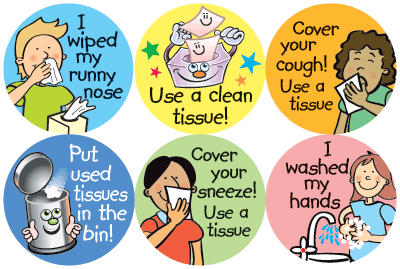Health
and Hygiene:
Health
is formally defined is as a state of complete physical, mental and social
well-being. We think of health as being free from diseases but it is much more
than just the absence of diseases in body. Good health enables to work free
from stress. A healthy body should have proper functioning of all body organs.
It also involves feeling well both in body and in mind.
In
order to stay healthy we should be hygienic. The various practices that help in
maintaining good health are called hygiene.
Personal
Health:
To
stay healthy and hygienic, first and foremost step is to take care personal
health. Maintaining personal hygiene is a necessary step towards staying free
from diseases.
Some
of the important aspects of personal hygiene are:
1.
Balanced diet:
A balanced diet is
one that gives body the nutrients it needs to function correctly. It also
includes the correct proportion of carbohydrates, proteins, vitamins, minerals
and roughage in diet.
In order of get proper
nutrition one should consume fresh green vegetables, fresh fruits, whole
grains, nuts, grams, etc.
2. Personal
hygiene:

There are some activities one should perform every day in order to
stay clean.
These activities are:
- Regular bowel movements keeps the body free of wastes that are generated within the body. Hands should always be washed after using the toilet.
- Washing hands before and after meal is must. Having food with dirty hands may make us sick as the dirt in our hand might carry certain disease causing germs.
- Bathing regularly keeps the body free of dirt, germs and free of body odor. It’s very important to wear clean undergarments and clean clothes.
- After eating food, some food particles may remain sticking to teeth. These food particles form a medium for the germs to grow, harms gums and teeth, and cause bad breath and plague. Brushing of teeth every day after every meal or two times a day do not let the germs grow. Brushing of teeth before going to bed is a very good habit.
- Regular washing and combing of hair helps in preventing dirt accumulation to keep the germs away. It also prevents lice and dandruff. Nails should be clipped regularly; nail biting is unhygienic and must be avoided.
3.
Domestic
hygiene
- House should be kept clean and free from dirt, flies and germs.
- Cooking utensils, plates, cups and other utensils should be kept clean and should be washed with proper dish wash soap.
- There should be separate dustbins for biodegradable and non-biodegradable wastes.
4.
Clean food and
water
- Fruits and vegetables should be washed in clean water to make them free from germs and pesticides before cooking.
- Water used for drinking, cooking, bathing and washing utensils should be from a clean source.
5.
Cooking with
care:
- Food should be prepared in a clean kitchen and in a clean manner. While cooking food, it is important to heat it to high temperature to kill any germs present in it.
- Cooked food should be eaten fresh or stored in cool, and away from flies.
- Milk stored in the refrigerator or outside should be boiled again to make it germ free.
6.
Abstaining
from addiction:
To keep healthy, one should
avoid smoking, chewing of betel nut, gutka and tobacco, and drinking alcohol.
Intake of such substances regularly leads to addiction and health issues like liver
damage, kidney failure, lung cancer and heart failure.
7.
Exercise:
Regular walking and physical
exercises have a good effect on health. Outdoor games and sport maintain the
heart and circulatory system in good condition. Walking keeps the joints of
bones healthy.
8.
Regular sleep
and relaxation:
These also play an important
part in maintaining mental health. They also help in the repair of body
tissues.

Disease:
Disease
is the sickness of the body or the mind. More specifically, disease is the disorder of structure or function of
a human body, and produces specific symptoms or affects a specific location and
is not simply a direct result of physical injury.
A
disease can be as mild as a sore throat, common cold, and stomach upset or as
serious as cancer. Disease can strike any part of the body and anybody at some
stage or the other.
There
are two main categories of disease:
1.
Communicable
Disease
2.
Non-communicable
Disease
1.
Communicable
Disease:
Diseases that spread through
air, water and physical contact or through vectors like flies and mosquitoes
are termed communicable diseases. They are transmitted from infected person to
a healthy person by means of physical touch or using the infected person’s used
things like clothes, towels, utensils, etc. They are also spread by body
fluids.
Communicable diseases are
caused by bacteria, virus or other pathogens.
Few examples are malaria, cough
and cold, measles, pox, etc.
There are two methods by which
germs are spread:
a. Direct
Method: By direct contact with the infected person.
b. Indirect
Method:
·
Touching and
sharing items used by infected person
·
Contaminated
food or drink
·
Blood
transfusion from infected person.
·
Through
vectors
·
Through air
2.
Non-communicable
Disease:
Diseases that don’t spread from infected person to a healthy person through
physical contact are non-communicable diseases. These are not caused by
pathogens.
These diseases may be caused
due to dietary deficiency (rickets, scurvy and kwashiorkor), genetic defects,
hormonal imbalances, allergy, etc.
A disease that affects a large
population in a particular area is considered to be an epidemic.
Steps
that prevents serious health deterioration of a patient’s health condition
during emergency or before getting proper medical care and help is called First
Aid.





No comments